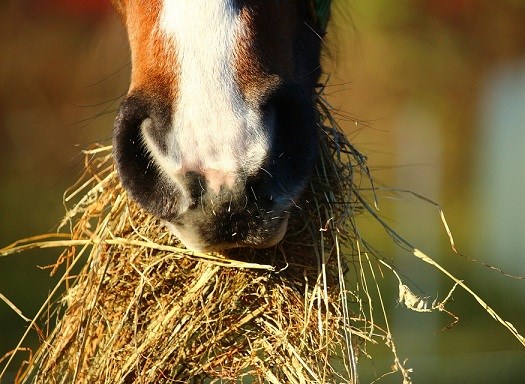Contact
Karin Morgan
Adjunct Senior Lecturer at the Department of Anatomy, Physiology and Biochemistry (AFB); Division of Equine Studies
E-mail: karin.morgan@slu.se

Interest in the use of open barns on Swedish horse farms is increasing as an alternative to keeping horses in box stalls and as a 2007 law requires phasing out of tie stalls. To provide adequate forage to satisfy welfare requirements for nutrition, gut health and behavioural needs, the use of automated feeding is also increasing. Studies on forage intake rate report wide variation but provide little information on how to introduce horses to an automatic forage station and on how forage intake rate varies in individual horses fed using an automatic forage station.
This study documented the process of training 22 horses to use a transponder-controlled automatic forage feeding station and measured forage intake rates. Observations on the learning period of horses for transponder-controlled automatic forage stations showed that after 4 days, 48% of the horses had reached the goal of 90% intake. After 8 days, learning was completed in 71% of horses and at 16 days in 95% of horses.
Measurements of forage intake rate revealed significant differences between individual horses. Overall mean intake rate ± SD, based on 314 observations, was 22.4 ± 6.7 min/kg forage DM. Evaluation of the number of intake measurements required to set a representative average ration in the automatic station for an individual horse showed that the variation levelled off at four samples.
In conclusion, horses quickly learned how to use an automatic forage station, with two-thirds of horses achieving this within 7 days. To ensure the correct ration in a timed transponder-controlled automatic forage station, each horse’s forage intake rate must be measured at least four times to obtain a representative average.
https://doi.org/10.1016/j.animal.2020.100152
Kjellberg, L. & Morgan, K. Introduction to automatic forage stations and measurement of forage intake rate in an active open barn for horses. Animal. 2021: 15(3):100152.
Karin Morgan
Adjunct Senior Lecturer at the Department of Anatomy, Physiology and Biochemistry (AFB); Division of Equine Studies
E-mail: karin.morgan@slu.se